|
< Earlier Kibitzing · PAGE 3 OF 3 ·
Later Kibitzing> |
| May-15-07 | | BabalooMoon: <Sargon 1 > If 20.Ne4 then 20...Qb5 and I think White is still lost. |
|
| Nov-04-07 | | nimh: Rybka 2.4 mp, AMD X2 2.01GHz, 10 min per move, threshold 0.33. Rosanes 2 mistakes:
18.Na4 -5.23 (18.a4 -0.96)
20.a4 #4 (20.Ne4 -1.62)
Anderssen 2 mistakes:
14...Bf5 -0.71 (14...Qe7+ -1.87)
18...Qa6 -1.49 (18...Qb4 -5.23) |
|
| Oct-13-08 | | CharlesSullivan: If 14.Kf2, Kasparov (in MGP-I, pp.29-31) gives 14...Nxh1+ 15.Qxh1 g3+ 16.Ke1 Qe7+ 17.Kd1 Bg4+ 18.Bf3 Bxf3+ 19.gxf3 Rg8 20.Qg2 Qxh4 21.Ke2 Qh2 22.Kf1 h5 and "the advance of the h-pawn is decisive." If we continue with Kasparov's idea, play would be 23.Nc3 h4 24.Ne2 h3 25.Qg1 Kg7 26.Bd2 Kf6 27.c4 Kf5 28.Rd1 Bc7 29.c5 Bd8 30.Bxf4 g2+ 31.Kf2 Bh4+ 32.Ke3 and Black's kingside threats look impressive:
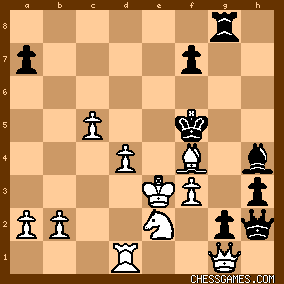
click for larger view
But White has an extra knight and pawn; after 32...Qxg1+ 33.Nxg1 Re8+ 34.Kd3 Kxf4 35.Nxh3+ Kxf3 36.Ng1+ Kf2 37.d5 Rh8 38.Nh3+ Kg3 39.Ng1 Bg5 40.Ke4 the computers cannot find a win for Black, who is still a pawn down. After 14.Kf2 Nxh1+ 15.Qxh1, Black has a somewhat lengthy winning line that begins with 15...Kg7! (instead of Kasparov's 15...g3+). But the best way to win after 14.Kf2 is 14...Ba6! 15.Bd5 Nxh1+ 16.Qxh1 g3+ 17.Kf3 Qf6 18.Nc3 Rg8 19.Bc6 Qf5 and White is busted; for example: 20.Qd1 Qg4+ 21.Ke4 Qg6+ 22.Kf3 f5! 23.Bxf4 Qg4+ 24.Ke3 Bxf4#. The "best play" line is probably 14.Kf2 Ba6! 15.Nc3 Nxh1+ 16.Qxh1 g3+ 17.Ke1 Qxa8 18.Kd1 (if 18.d5 then 18...Qc8! 19.Bd2 Qc5! etc.) 18...Bb7 19.Bxf4 Bxf4 20.Qf1 Qb8 21.Ne2 Bh6 22.Qf6 Bg7 23.Qf1 Rg8 24.c3 Bh6 25.b3 Qd8 26.Qh1 Qf6 27.Kc2 Qf2 and Black's winning advantage is clear. |
|
| Oct-14-08 | | CharlesSullivan: Kasparov [in MGP-I, p.31] tries to refute Reti's suggested 15.Bc6 with 15...Qe7+ 16.Kf2 Ne4+
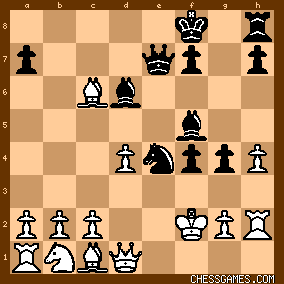
click for larger view
17.Bxe4[??] g3+ 18.Kg1 gxh2+ "etc."
but 17.Kf1! should prompt Black to play 17...Ng3+ 18.Kf2 Ne4+ 19.Kf1 Ng3+ with a draw by repetition, since 17...g3 18.Rh1 Nf2 19.Qe2 Nxh1 20.Qxe7+ Kxe7 21.Nc3 leaves White with an extra pawn and the winning chances. |
|
| Oct-14-08 | | CharlesSullivan: <After Reti's 15.Bc6>, Black's winning line is 15...Qb6! (not Kasparov's 15...Qe7+). The main variation continues 16.Ba4 Qa6 17.Kf2 Qxa4 18.Na3 Bxa3 19.Bxf4 Ne4+ 20.Kg1 Bxb2 21.c3 Qc6 22.g3 Bxa1 23.Qxa1 Kg7 and <Black has a knight for a pawn and a clearly winning position.>
Other tries for White after 15.Bc6 Qb6! are (a) 16.Bd5 Kg7! (b) 16.Ba8 Kg7! and (c) 16.c4 Qxc6 -- all of which can be shown to win for Black. |
|
| Oct-14-08 | | CharlesSullivan: The most interesting try to save the game is <15.Bf3!!>

click for larger view
Now 15...Qe7+ 16.Kf2 Ne4+ 17.Kf1! gxf3!? 18.gxf3 Ng3+ 19.Kf2 Qe6 20.Nc3 Qc4 21.Rg2 does not lead to a Black advantage, so the correct continuation is <15...gxf3! 16.gxf3 Rg8!! 17.Nc3 Qc8!!>

click for larger view
At this point, I have investigated many tries for White, such as (a) 18.Rf2 Rg6! 19.Qd2 Bb4 (b) 18.a4 Qe6+ 19.Kf2 Qg6 and (c) 18.Rg2 Bh3 19.Rg1 Qe8+, all of which come up short. The long main variation is <18.h5 Qc6 19.Qd2> (going for a variation in which queens come off the board) <19...Qxf3 20.Qg2 Qg4 21.Bd2 f3 22.Qg1 Ne4! 23.Qxg4 Rxg4>

click for larger view
White still has a material advantage (rook & pawn vs. bishop), but Black's attack rages; for example: <24.Bh6+ Ke8 25.Rh1 Nxc3 26.bxc3 Rg2 27.Rc1 Be6 28.Kd1 Bc4 29.Be3 f2 30.Bxf2 Rxf2 31.Rg1 Bf4 32.Rb1 Kf8>
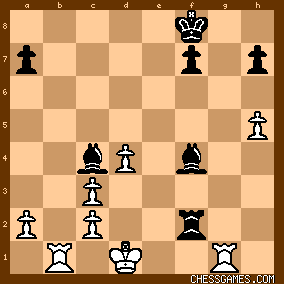
click for larger view
At this point you can see that White's position is dire, and after <33.Rb4 Bd5 34.Ke1 Rh2 35.Rf1 Bd2+ 36.Kd1 Bxc3 37.Ra4 a5 38.Ra3 Bxd4 39.Rf4 Bb6>
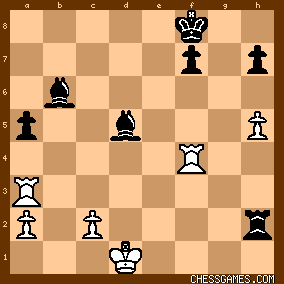
click for larger view
Black has, at last, a clearly won position.
|
|
| Feb-20-09 | | dwavechess: 18/23 78%! for Anderssen with Rybka 3 at 3 min. per move |
|
| Apr-14-10 | | The Rocket: Beautiful |
|
| Jul-22-10 | | jbtigerwolf: I liked 12...♗d7. It looks as if Anderssen botched the early middle game, but has won through sheer skill. I agree with refutor's comment of 8 years ago. He was some player! Interesting how he tried to hang onto the pawn, unless it was a ruse. Can't help but feel White must have made a mistake somewhere. |
|
| Sep-10-10 | | sevenseaman: Its a very dramatic finish. This is incomparable entertainment. |
|
| Sep-10-10 | | sevenseaman: <Sneaky> Your 8-year old comment seem so apt. |
|
| Sep-12-10 | | Whitehat1963: Wednesday/Thursday puzzle after 20. a4. |
|
| Mar-20-11 | | zev22407: Any interesting ideas on 14)R-g1?
I think 14)..K-g7 To free the rook on h8 |
|
| Mar-31-12 | | henjutsu: Didn't see anyone discussing this possibility, thought I'd throw it out. I think an alternative winning variation for Anderssen after 19 could have been: ...Bxc2.
The only safe spots for the queen are Qg2, Qd2, Qxc2. If 20) Qd2 or Qxc2, black can respond with Qf1++.
If 20) Qg2, then ...Re2+. Nxe2, Qxe2++.
This isn't as pretty of a win as what Anderssen played though. Blocking with the white d5 bishop or c3 knight does not change the situation. Perhaps the only defense vs this attack could be Bxf4, but that still loses the queen for white. |
|
| Jul-13-12 | | Amarande: The 19th century game collection "Chess brilliants" by John Odin Howard Taylor cites this same win by Anderssen (Game 2), but gives White's name as a "Herr Mieses." Tartakower and du Mont's 500 Master Games of Chess on the other hand cites White as having the surname Rosanes. Which is correct, or did Anderssen not only win this classic brilliancy for Black in the King's Gambit, but did so twice, against different opponents? |
|
Jul-13-12
 | | Phony Benoni: <Amarande> Interesting. Rosanes is the only name I ever recall seeing associated with the game, but Samuel Mieses (Jacques' uncle) attended Breslau University around this time and was a pupil of Anderssen. Worth investigating. |
|
| Jul-28-13 | | Chessist: http://www.chesshistory.com/winter/... |
|
| May-26-14 | | rossvassilev: why not 20.dxe5? |
|
| May-26-14 | | Karpova: <rossvassilev: why not 20.dxe5?> 20...Qb6+ 21.Ke1 Qg1+ 22.Kd2 Qe3# (sacrificing the ♕ or ♗c1 won't stop mate). |
|
| Jan-23-16 | | Joker2048: Anderssen has no fear of the loosing his queen or his knights or rooks or bishops. He's just going for mate his opponent, what a brilliant player, I've seen many mates from this guy and I know he's the God of courage. Bravo |
|
| Nov-03-16 | | Hunter16: Can anyone tell me if 21...B×d4 also wins?
Thank you. |
|
| Nov-03-16 | | bachiller: <Hunter> 21...Bxd4 was actually played. Perhaps you mean 20...Bxd4? |
|
| Jun-07-18 | | yadasampati: <Hunter16> It seems not. 20...Bxd4+ 21. Qxd4+, followed by Bxf4 and white has no more problems |
|
Nov-16-20
 | | MissScarlett: <henjutsu: Didn't see anyone discussing this possibility, thought I'd throw it out. I think an alternative winning variation for Anderssen after 19 could have been: ...Bxc2.
The only safe spots for the queen are Qg2, Qd2, Qxc2. > I spotted that, too, only to realise that Bxc2 unprotects g4. At which point, it's curtains. |
|
| Feb-06-23 | | generror: Another classic wild King's Gambit game. Just check out the position after <10...dxc6>: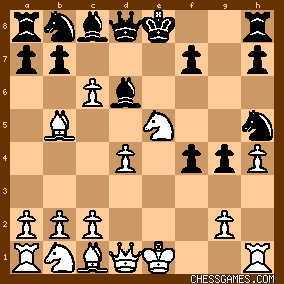
click for larger viewPawn structures do not exist, the queensides are all virginal, the kingsides are ravaged, To me that's a *nightmare*, but back then people seemed to have enjoyed such a mess. Well, back then it was normal to beat up children too, which just may have something to do with the fact that battles back then were essentially kindergarten brawls. At least in chess it's fun to watch because nobody gets hurt. <12.Kf8?!> is of course an amazing move, sacrificing a rook for nothing but a tempo. But even though Tartakower said that <12...Bd7 13.Bxd7+ Qxd7 14.O-O> (D) "deprives Black's attack of all vitality", to me and Stockfish it looks better: White is up a pawn, but its queenside is completely undeveloped, while the black pieces are nicely active and there's a mass of pawns waiting to go down onto the king and his measly little pawn. 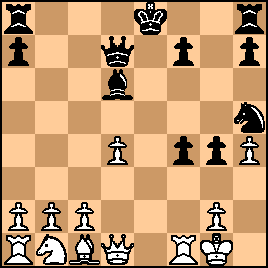
click for larger viewBlack isn't the most accurate, but White's defense isn't the best either, plus his position actually is so @#$%ed-up that I'm not sure there is any real defense. But <19...Be5!> really *is* a lovely move, and while <20.Ne4> could have defended a little more, Anderssen's final mating combination is just really beautiful and irresistible and makes up for the game which I personally find hard to call beautiful. |
|
 |
 |
|
< Earlier Kibitzing · PAGE 3 OF 3 ·
Later Kibitzing> |





